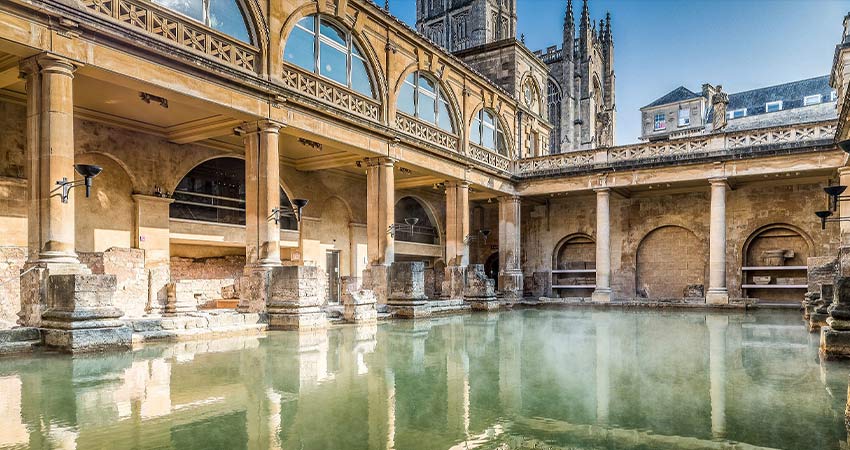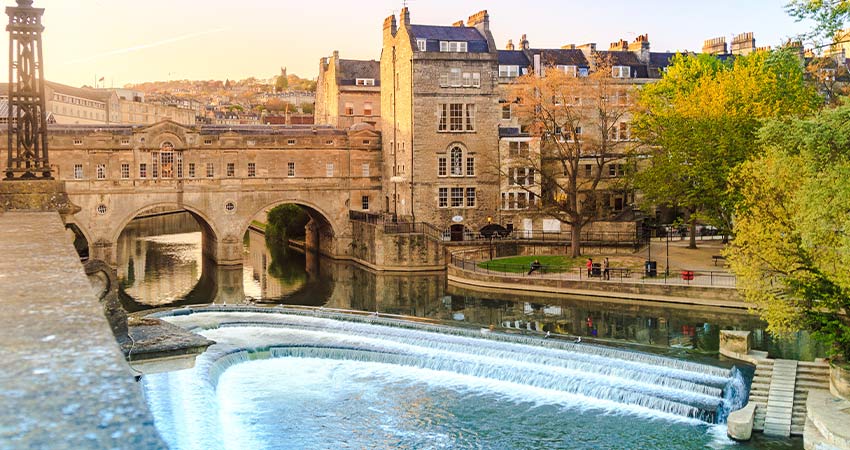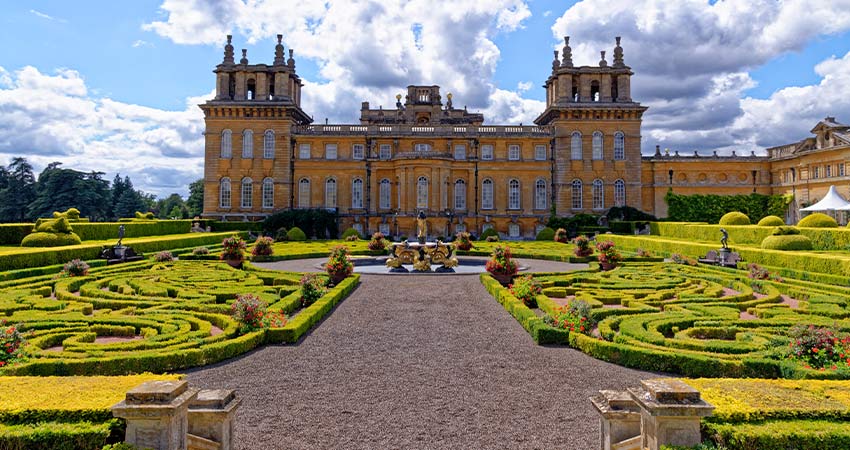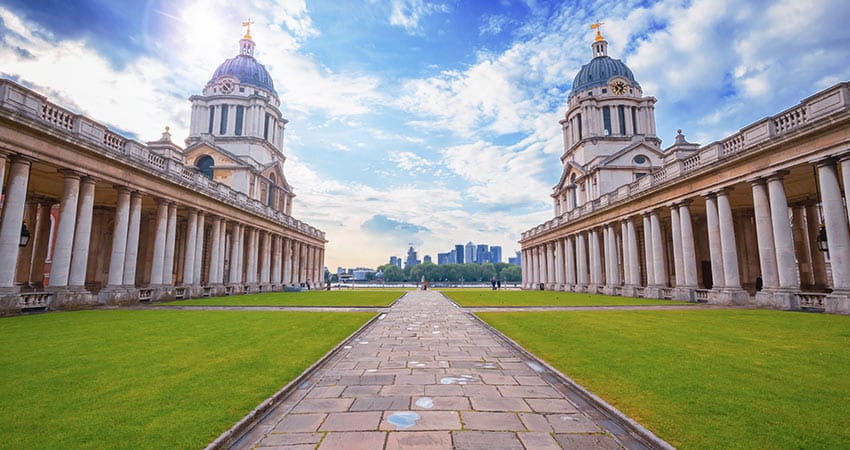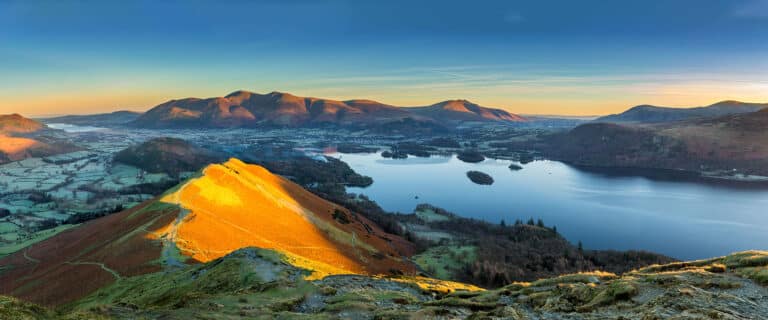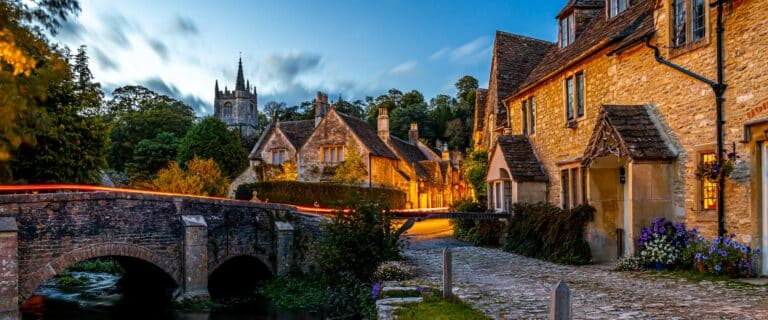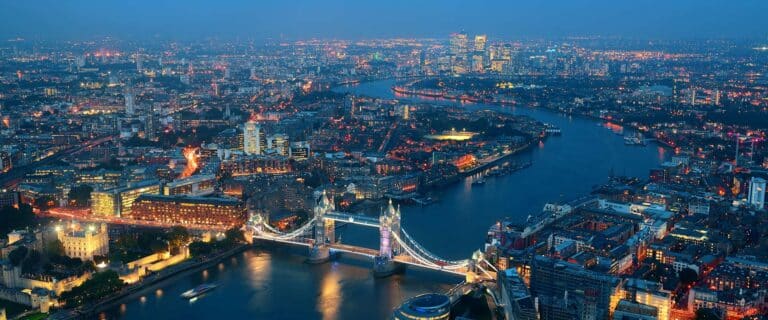People have lived in Southern England for thousands of years, so it’s no wonder there are a number of UNESCO sites you can visit. Stonehenge, Avebury, and ancient stone circles are older than Egypt’s pyramids. Bath has two UNESCO designations—one as the city itself, and one as part of The Great Spa Towns of Europe. Coastal areas, a palace, botanical garden, cathedral, and a nod to the Industrial Revolution round out the list.
Here are astounding, must-visit sites for anyone traveling to southern England.
Bath
Local legend has it that Bath originated when a Celtic king, Bladud, discovered the healing properties of steaming mineral waters in 860 BC. In the 1st century AD, the Romans trudged through and built formal baths around the spring as well as a temple dedicated to the goddess Sulis Minerva. (Her name is a combination of the Celtic water goddess Sulis, and the Roman goddess Minerva.) Later, medieval monks fell in love with the waters.
When Queen Ann visited in the early 18th century, Bath reached its height of glory. High society gathered here to meet and take the waters. The entire Bath complex was rebuilt in the style of Bath’s Roman era. The Great Bath, discovered in 1870, revealed complex Roman caves and a unique look at the power of Roman engineering. Today, you can see artifacts and the original structure. The Pump Room is now a centuries-old tea room.
Bath received a UNESCO designation because it reflects two great eras in human history: The Roman and the Georgian. The remains of the city Aquae Sulis give us an understanding of the era’s social and religious structure. In its urban design and social setting, 18th century Bath is a perfect example of a Neoclassical city. A Medieval church, Roman buildings and temple, and Georgian homes sit harmoniously together. While you’re there, dip into the Thermae Bath Spa and then head to one of the cozy tea shops.
Cornwall and West Devon Mining
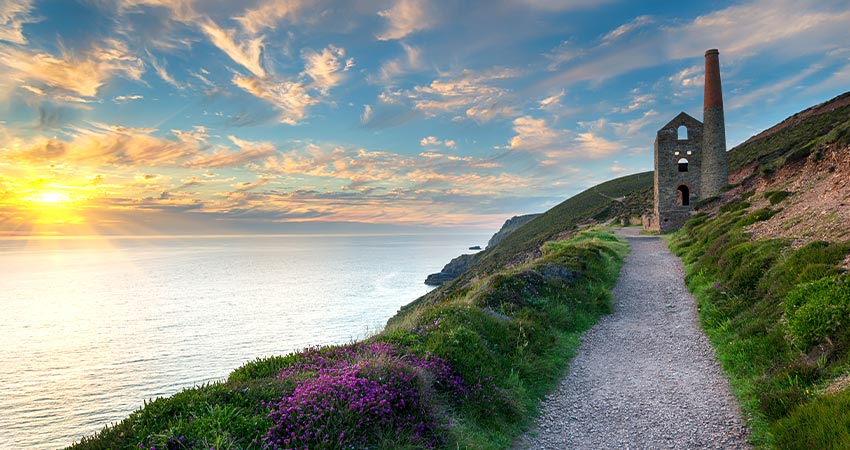
Some parts of Cornwall and Devon were settled in the Stone Age. During the Iron Age, Celtic tribes hid out there. They had their own language, which was the same as the Welsh and Bretons, although lost in the 18th century. Sir Walter Raleigh and Sir Francis Drake set sail on rip-roaring adventures from this site, and the legends of King Arthur of coastal Cornwall grew. When the 19th century came in, so did the tin and copper mines.
A lot of the landscape was changed during this time. Underground mines, engine houses, foundries, new towns, ports, harbors, railways, canals, docks, and industries give us a picture of fast-growing innovation. This area supplied two-thirds of the world’s copper and is a look into the rapid rise of the Industrial Revolution. Cornish technology was used in the creation of engines, engine houses, and mining equipment worldwide. At seventy-seven square miles, this is the largest industrial World Heritage Site in the UK.
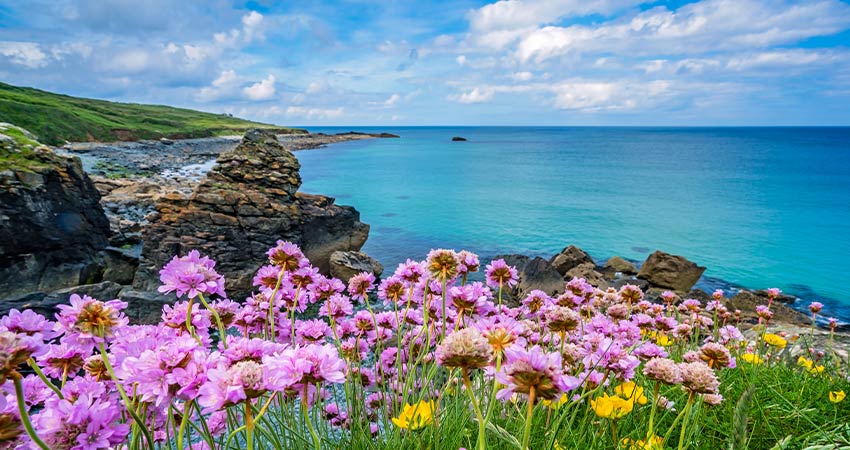
While you’re in Cornwall and Devon, travel to lovely nearby towns, including St. Ives, with sweeping views across the ocean; Dartmoor National Park, a vast moorland with Neolithic tombs and medieval farmhouses; Exeter, Devon’s capital built on a high plateau with spectacular medieval buildings; the Lizard Peninsula, with charming villages and sandy beaches; and Falmouth, situated where seven rivers flow and with the deepest harbor in the world, after Sydney and Rio de Janeiro.
Dorset and the East Devon Coast
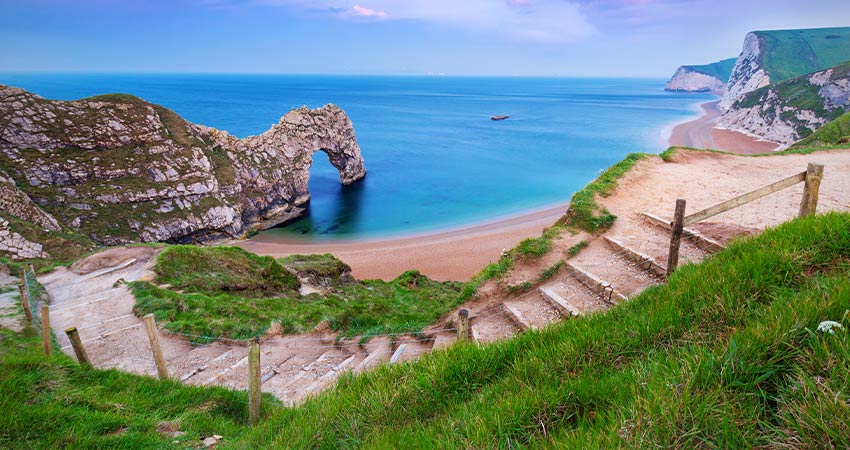
The cliffs along the Dorset and East Devon Coast have a series of rock formations that span 185 million years of history. For more than 300 years, scientists have studied this area, and its fossils, to learn Earth’s early story. Largely unspoiled, geologists and paleontologists consider this to be one of the most significant research sites in the world. From here, they learn about the Triassic, Jurassic, and Cretaceous periods. This area is home to another UNESCO World Heritage Site, the Jurassic Coast.
While you’re there, visit the coastal city of Dorset. With a population of 500,000, there is something to please everyone. Portland Castle, overlooking the port, is one of Henry VIII’s best coastal forts, and Bournemouth Pier has a range of reef and water activities. Enjoy wine tasting? Dorset has beautiful vineyards and wines that have won numerous international awards—make your way to Langham Wine Estate or English Oak Vineyards near the town of Poole. Like to cook? Dorset offers masterclasses led by local chefs and artisanal producers, including hedgerow foraging, cake decorating, and bread making!
Stonehenge, Avebury, and Associated Sites
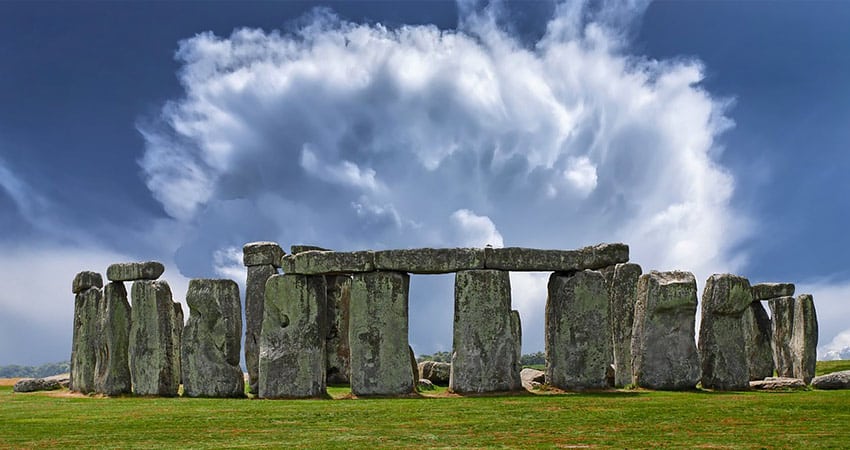
We don’t know the specific rituals that took place at Stonehenge, but we do know the circular stones are aligned in such a way that the structure had to do with the sun and the seasons. Abandoned more than 1,000 years before the Druids arrived, its scale and size are mind-boggling. The only tools people had were stone, wood, and bone. How they marshaled the power to raise these massive stones, and do so perfectly, is an utter mystery. There are also prehistoric burial mounds close to the temple.
Nearby Avebury is one of the main ceremonial sites of Neolithic Britain, built from 2850 BC to 2200 BC. There is a huge circular bank and four entrances. Inside is an inner circle of upright stones that surrounds two more stone circles, each with a feature in the center. Walk a path of stones, about one mile southeast, and you’ll come to the Sanctuary stone circles of Overton Hill.
During the Middle Ages, a dark time, these stones became associated with pagan or devil worship. Many were buried or destroyed. Andrew Keiller, heir to a marmalade fortune, bought the site in the late 1930’s, clearing away buildings and raising the stones again.
Blenheim Palace, Oxfordshire
Blenheim Palace has made 71 appearances in movies and television, more than any other English country house, so when you visit it may look familiar! It is a masterpiece of Baroque architecture and has one of Europe’s largest collections of portraits, furnishings, sculptures, and tapestries. The library has more than 10,000 books. The ancestral home of the Dukes of Marlborough, this was Winston Churchill’s birthplace.
In 1892 the palace was in disrepair, and the dukedom was near bankruptcy. Charles, 9th Duke of Marlborough, came up with a solution—he married the American heiress, Consuelo Vanderbilt. Repairs began while the two were on their honeymoon. The party held here on July 7, 1939, is said to be, “the last season ever.” There were 700 in attendance, including Winston Churchill, future Prime Minister Anthony Eden, and the young John F. Kennedy.
When you visit Blenheim, you’ll find the formal gardens and the pleasure gardens are small miracles of beauty. Duck into the Churchill exhibit for a commemoration of the great man’s life. The stables exhibition celebrates the importance of horses throughout the palace’s history. Blenheim is the only country house that is officially called a palace, a well-deserved title.
The Old Royal Naval College, Greenwich
The Old Royal Naval College in Greenwich won England’s “Large Visitor Attraction of the Year” in 2020. Hear the tales at this stunning 17-acre site. This was the birthplace of Henry VIII. St. Peter and St. Paul boasts wondrous 18-century art and furnishings. An underground tunnel connects the Chapel to the Painted Hall. Here you’ll find one of the few remaining Skittle Alleys.
The Painted Hall is known as “The United Kingdom’s Sistine Chapel.” It took nineteen years to paint, and there are 40,000 square feet of Baroque walls and ceilings. They are painted with extraordinary images, featuring 200 figures of kings, queens, and mythological creatures.
The Old Royal Naval College is one of the most popular film locations in the world. The exterior is magnificent, and the Painted Hall and Chapel have starred in such films as The Crown, Les Misérables, Thor: The Dark World, Cruella, Bridgerton and many more. Consider a film tour for an insider’s take on trade secrets.
Royal Botanic Gardens, Kew, Surrey
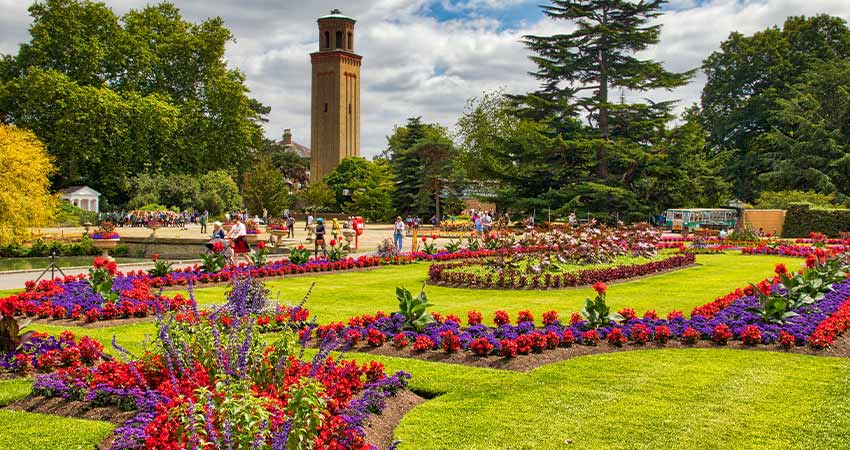
Kew Gardens, set on 326 acres, has the world’s most diverse collection of living plants. The garden began in the 18th century and became a UNESCO World Heritage Site in 2003. A land train with six stops takes visitors throughout. The Palm House has tropical rain forests, and the Temperate House is a hothouse cathedral of 1,200 plants from every temperate corner of the world. Delicate and endangered plants get their start here until they can withstand the UK’s winters.
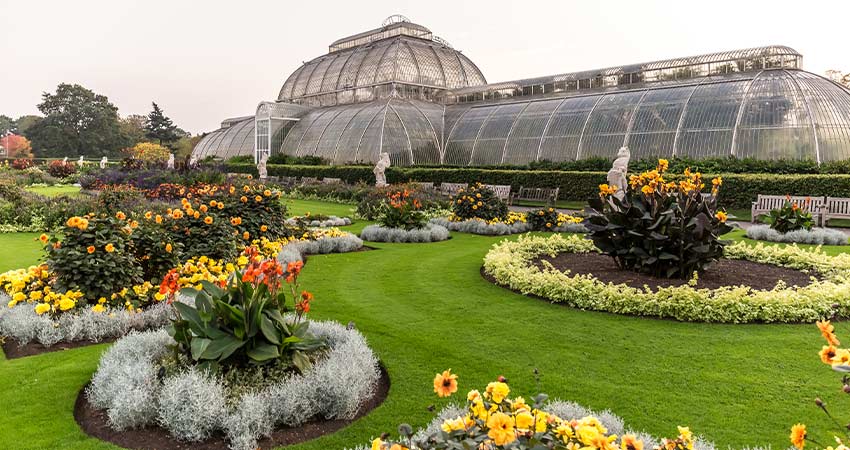
Walk inside the gallery for unique botanical art and then into Kew Palace, the summer residence of George III. The Hive is an amazing installation that showcases the dangers honeybees face, and the Great Board Walk has borders with over 30,000 plants. They provide an array of colors from the spring through the fall. Finally, the Treetop Walkway has views of the forest canopy, alive with insects and lichen.
Canterbury Cathedral, Kent
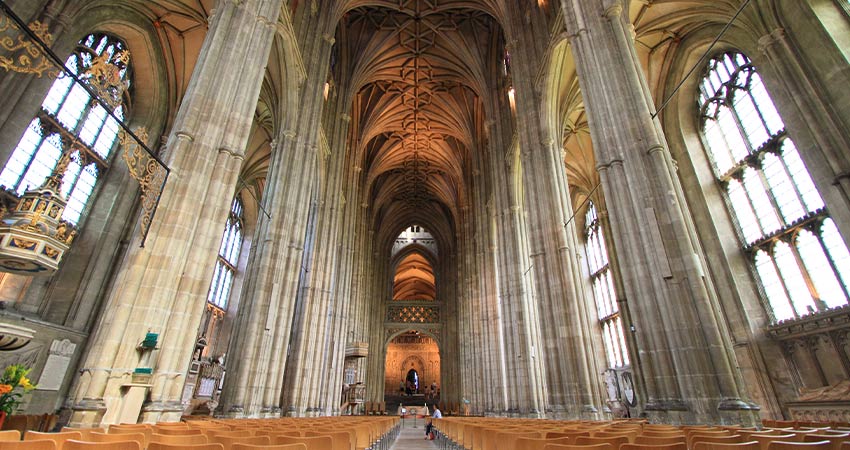
The spiritual center of the Church of England for 500 years, the Canterbury Cathedral, St. Augustine’s Abbey, and St. Martin’s Church are splendid. Built in the 11th century, the atmosphere is rich with English history—you can almost hear Thomas Becket’s footsteps. Canterbury was the most important pilgrimage site in the medieval world—this is your chance to experience 1,400 years of England’s history.
When you travel to London, consider going to Southern England and visiting a few glorious UNESCO World Heritage Sites. These are designated as some of the most significant sites in the world and each is breathtaking.
Let your Destination Expert know that you want to step into England’s story by visiting a UNESCO World Heritage Site!


